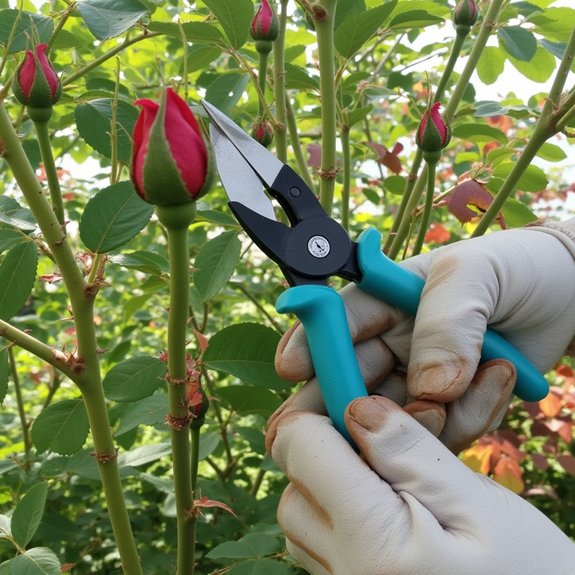Have you ever wondered why some gardeners’ roses bloom magnificently while yours struggle to produce lackluster flowers? The secret lies in mastering proper pruning techniques that most people get completely wrong. You’ll discover that timing your cuts between late February and early April, using sharp bypass pruners, and creating that essential open vase shape transforms weak, disease-prone plants into vigorous bloomers. But there’s a significant mistake that even experienced gardeners make during their first cut.
Contents
- 1 When to Prune Your Roses for Optimal Health
- 2 Essential Tools and Preparation for Rose Pruning
- 3 Basic Pruning Techniques for All Rose Types
- 4 Special Care for Once-Blooming and Climbing Varieties
- 5 Tailoring Your Approach: Hybrid Teas vs. Shrub Roses
- 6 Post-Pruning Care and Seasonal Maintenance
- 7 Common Pruning Myths Debunked
When to Prune Your Roses for Optimal Health

Everyone knows timing matters with roses, but many gardeners struggle to pinpoint the perfect pruning window. Your best pruning indicators aren’t calendar dates—they’re natural signals like forsythia and serviceberry blooms. These plants flower when seasonal temperatures stabilize, typically February through April.
Wait until after your area’s last hard frost to avoid cold damage. You can do light pruning throughout summer, but save major cuts for this spring window. Fall pruning prevents fungal issues, though you’ll want to wait until dormancy begins.
Once-blooming varieties break this rule—prune them right after their first bloom instead.
Essential Tools and Preparation for Rose Pruning
Three essential tools transform your pruning from a frustrating chore into efficient garden maintenance. Sharp bypass pruners handle most cutting tasks, while bypass loppers tackle larger canes. Keep a small handsaw handy for thick, stubborn growth.
Tool sanitization prevents disease spread between plants. Clean your pruning tools with Lysol or rubbing alcohol before starting, then keep sanitizer within arm’s reach during work. Sharp blades create clean cuts that heal properly, so maintain your tools regularly.
Quality equipment makes the difference between ragged, damaging cuts and precise, plant-friendly incisions that promote healthy regrowth.
Basic Pruning Techniques for All Rose Types

While different rose varieties have specific needs, all roses share fundamental pruning techniques that form your foundation. Start by removing the “three D’s”: dead, diseased, or dying canes and foliage completely. Next, create a vase shape with an open center for airflow, which prevents disease. Cut back to outward-facing bud nodes to encourage growth away from the center, and eliminate suckers from below the graft to prevent takeover. For overgrown bushes, hard prune by cutting back one-third or more. These core principles work across all rose varieties, ensuring healthier plants.
Special Care for Once-Blooming and Climbing Varieties
Once-blooming varieties like ramblers, species roses, and Old Garden roses break the standard pruning timeline, requiring you to wait until after their first bloom instead of pruning in early spring. This once blooming care prevents removing growth that produces spring flowers.
Climbing varieties need special attention after pruning. You’ll want to tie side shoots to supports, encouraging horizontal cane growth for maximum blooms. Unlike hybrid teas with rigid upright growth, climbers benefit from pegging—bending canes outward and securing them to structures.
Tailoring Your Approach: Hybrid Teas vs. Shrub Roses

Understanding the fundamental differences between hybrid tea and shrub roses will transform how you approach pruning each variety. Hybrid teas feature rigid, upright canes that should grow vertically. Cut above bud nodes to encourage new growth, maintaining their classic vase shape.
Shrub roses, however, benefit from horizontal cane growth like climbers. You can use pegging techniques, bending canes outward and securing them to supports. This encourages more blooms along the entire cane length.
These distinct pruning techniques reflect each rose varieties’ natural growth habits. Hybrid teas want structure, while shrub roses thrive with flexibility and creative training methods.
Post-Pruning Care and Seasonal Maintenance
After you’ve completed your spring pruning, your roses need proper nutrition and consistent care to recover and thrive throughout the growing season. Feed them with compost or slow-release fertilizer to jumpstart new growth. Post pruning watering becomes essential—established plants need water weekly when the top few inches of soil feel dry, while younger roses require watering up to three times weekly.
Continue deadheading spent blooms throughout summer by snapping off flowers or cutting above 5-7 leaflets. This seasonal fertilization and maintenance routine encourages continuous blooming until late summer, when you’ll stop deadheading to promote dormancy.
Common Pruning Myths Debunked
Despite years of gardening wisdom being passed down through generations, many rose pruning “rules” are actually outdated myths that can confuse or even harm your plants. You don’t need to cut every cane at a 45-degree angle—clean, straight cuts work fine. There’s no magic formula for how much to prune, as pruning benefits vary by plant health and rose varieties. You shouldn’t seal cuts with compounds unless cane-boring insects threaten your area. Most importantly, you don’t need perfect technique to succeed—sharp, sanitized tools and removing dead wood matter most.
